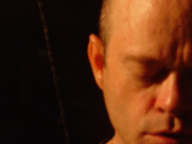Orlando's Folk-Rock Self-Psychiatrist Widens His Dream of Beautiful Torment
by Dane Janz

"I've got it, it's OK."
You hear that, or variations of that, from
Stephen Grayce a lot lately. Grayce, the Orlando songwriter / musician
/ artist / singer (in the order he deems correct skillwise) whose 6-song
2002 EP
Day One captured a man dealing belatedly with protest, mystery,
loneliness and much much grief, reaches for the glass of apple juice this
reporter has just knocked over on a marble coffee table. It's a big stretch
of faith for someone who, this time two years ago, wasn't sure he had it
at all.
But he may certainly have to get used to having
it, and having more. More career, more respect, certainly more listeners.
As he prepares to release Day One's followup, Looking
For Light, he certainly has more discipline than he imagined. He spent
the previous day recording the song "Gone", an 8-minute-plus where-is-love
question without an answer. Described by one reviewer as "Coldplay with
cajones",
the song went from zero to finished, complete with five intertwining guitar
parts and solos, in a 14-hour, 1-man session, a nonstop brew of bliss and
heartache.
"The song just took over," he explains from
his third-floor apartment, soon to be vacated for new digs complete with
mini-studio in a nearby suburb. "The lyrics were basically there from a
previous try a few months ago that didn't feel right, too ambient. Then
I was thumbing through sample loops on my computer and hit upon a beautiful
keyboard-string figure, three chords that were solid but open to interpretation.
I started layering guitars and percussion almost mathematically, seeing
what worked in more than one way in the same song. As the intricacy really
started to pile on it hit me, and I practically threw the headphones across
the room thinking, 'oh, hell, those lyrics go with this' and dug them up.
They fit perfectly. It blew me away." While it may be shortened for the
album, the original extended mix is being released on a CD single first,
with the non-album track "Airspeed" and a live version of Looking For
Light's "Billy Can Fly", from a Nashville webcast in early August.
And the listener may be blown away as well.
Tucked into a multi-genre, multidimensional album that pits basic pop-rock
(the Robert Palmer-influenced "Hit The Road"), ethereal folk ("Superman
For Free"), his version of California folk-rock ("Over") and a self-described
'French folk song' about the World Trade Center bombings ("Quiet Please")
against each other to great effect, "Gone" is a moment that many a brooding
sensitive songwriter dreams of: a song about being low that flies high.
It opens with the aforementioned keyboard chords, which are quickly transformed
by what may be the most memorable E-Bow guitar lick since David Bowie unleashed
"Heroes" on an unsuspecting planet, over an acoustic bedrock braced with
percussive bite. As the gliding, detached vocal floats above the beautiful
melancholy, the song becomes at first recognizably structured in the verse-chorus-solo
mold, only to expand into its own universe as parts from one section reappear
elsewhere in the song, note-for-note, in different structures than where
they began. That E-Bow wail that sets the tone at the beginning is repeated
at the end over not the intro chords but the chorus chords- and fits exactly
in less light than in its previous placement. When you first hear it, it's
flying; when it reappears, it's crying, without changing one bit. Finally
the song disintegrates instrument by instrument until it's....gone,
proof
that atmosphere can be everything.
"Yeah, I know, it sounds, to me at least,
really uplifting at the beginning because the base is a major chord," Grayce
explains. "Then by the song's end it's like it's on a sad kind of can't-anyone-hear-me
autopilot, wailing over a minor chord. Not hopeful, pretty much resigned
to its fate actually, but maybe more memorable for it. I like asking musical
questions and leaving the answers hanging just outside of the song, if
they're there at all. If you have to work just a little, maybe you'll listen
more closely for clues." And are the clues there? "Not telling," he laughs.
The multiplicity of approach revives what is mostly
a lost art: the album for album's sake. Each song fits into the puzzle
as a whole, even when the approaches and attacks vary wildly. From full,
intricate production to live-in-the-living-room guitar-and-voice folk (the
demo take of the early-Dylan-on-hallucinogenics of "High and Fine"), Grayce's
album is exactly what Grayce himself is: a collection of extremes, shadings,
similarities and jarring differences that coexist as a whole.
And Grayce's future plans are a perfect example
of these extremes. His next projects will be a hard-rock album, as yet
untitled, plus a quiet, folky album called Imperfect Heart, which
named itself when Grayce's first attempt at sculpture produced just that.
Add digital artwork and photography, and he can be one busy guy.
When he sets his mind to it, that is. The discipline
mentioned before comes and goes as it butts up against his hyperactive
mind and tendency to bore easily. "That was my worst problem during a long
writer's block, I just kind of sat there. So now all these ideas come to
me, and I do it in fits and starts. I'll slack off for a very long time,
then record an entire song in a day. I need to find a more even keel, but
I can't argue with the final results at this point."
And so the ends do indeed justify the occasional means.
This musical version of manic depression has thus far produced some great
music, and if Looking For Light is an indication, the results are
not only clearing the bar that Day One raised for Grayce, but are
also branching out all over the place. The continuing emergence of Stephen
Grayce should be an interesting trip indeed.